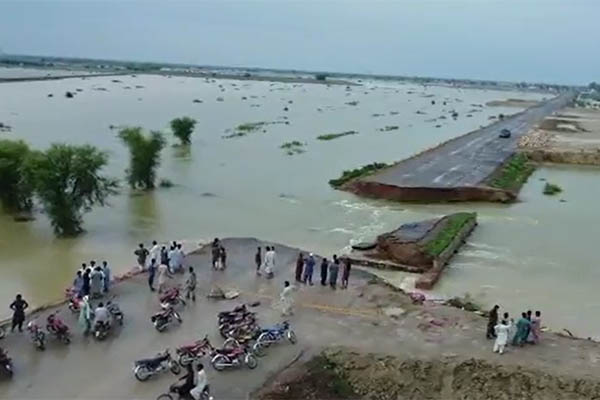
Roads have been washed away by the floods in Sindh
The full impact of the 2022 floods on Pakistan’s GDP remains unknown, but “reconstruction and rehabilitation activities” may increase costs by billions of dollars beyond the estimated losses of $30 billion, according to a case study released as part of the U.N. Environment Program (UNEP)’s Adaptation Gap Report 2023.
Titled ‘Cascading impacts and floods: Building adaptive capacity in Pakistan,’ the case study notes that last year’s floods were the most extensive experienced in Pakistan to date, pushing up to 9.1 million people into poverty, with a further 1.9 million falling into multi-dimensional poverty. Additionally, it said, the 2022 floods had ruined 26,305km2 of crops, a “particularly worrying” development in a country dependent on agriculture.
Summarizing the causes and effects of the 2022 floods, the case study recalled that the record-breaking monsoon rains began earlier than usual, with estimates that climate change worsened the situation by 50-75 percent. It said that while the main issue was Indus River flooding, urban flash floods, landslides and glacier lake outburst floods also contributed to the disaster. Additionally, it said, heatwaves in April and May had enabled a more intense monsoon, with more than three times the average annual rainfall falling across Pakistan, with more than five times the average falling in Sindh and Balochistan.
As a consequence of this, read the case study, 33 million people were displaced, 1,500 died, and 10-12 percent of the country’s total land area was flooded. The case study said damage and loss assessments were hampered by poor communication via collection forms; lack of monitoring of flooding over geographical areas; limited engagement with non-governmental organizations; and difficulty in verifying and quantifying satellite data.
The report stressed that the increasing frequency, scale and magnitude of climate extremes in Pakistan over the past three decades had caused significant loss of life, while triggering a reversal of development gains. “The compounding impacts of the climate crisis mean that for each climate disaster which occurs, the window to build back is getting smaller and people are falling deeper in the poverty trap,” it warned, adding these cascading impacts have eroded livelihoods and coping capacities.
According to the UNEP case study, the intensity and frequency of these events has increased since Pakistan was formed in 1947, with the most devastating floods to date occurring in 2022. Responding to these risks and impacts of the climate crisis, it advised, requires a transdisciplinary, cross‑scale and cross‑sector approach. “Understanding, identifying and attributing cascading effects to specific climate shocks and stressors is key to developing ways to build adaptive capacity and resilience. However, it is very likely that the costs of adaptation will be higher than anticipated,” it added.
